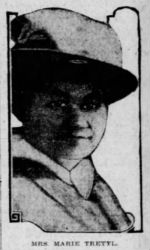A Doctor's Second Dead Patient, 1932
In late December of 1932, 20-year-old schoolteacher Myrtle Gardner of
Four Oaks, North Carolina checked into a Raleigh motel room with her
brother-in-law, George D. Clifton. The two presented themselves as a
married couple.The following day, the two went to the home of Mrs.
Carrie C. Forsythe, where they were to meet 45-year-old Dr. Mike
Roberson, of Durham, for an abortion.
After the abortion, Mrytle took ill. Clifton took her to a hospital,
where she was admitted under the name Mrs. George Clifton. She died from
septic infection caused by an incomplete abortion on the evening of
December 26. Dr. P. G. Fox reported her death to the police after Mrytle
gave a deathbed statement at the hospital to him, another doctor, and a
nurse.
Mrs. Forsythe, age 63 and described as "a gray-haired, middle-aged
Raleigh woman," was also charged with murder in Myrtle's death. She was
convicted and sentenced to 2 to 3 years for counseling and procuring the
abortion. She collapsed and had to be carried to her cell after hearing
the sentence. She spent the night "in a highly hysterical condition.
Mrs. Forsythe had been charged previously as an accessory to abortion.
Clifton was charged as an accessory in Myrtle's death as well.
Roberson was originally charged with first degree murder for Myrtle's
death, but the charge was reduced to second-degree murder. Roberson's
wife provided his alibi, saying that he was at home sick the night
Myrtle's abortion was perpetrated. His defense also asserted that the
prosecution had not proved that Myrtle had actually been pregnant.
Roberson pleaded nolo contendere and was given a 3 to five year
prison sentence. The medical board revoked his license, but
successfully convinced the court to suspend his prison sentence with the
stipulation that he never practice medicine again, both on the grounds
that he'd no longer be a danger if he stopped doing abortions and on the
grounds that he was suffering a heart ailment and thus would not fare
well in prison.
This was Roberson's fourth arrest on abortion charges. He had been convicted in the 1928 abortion death of Irma Robinson, but won a new trial on appeal.
A Midwife's Second Dead Patient, 1918
Rose Kulamer's
husband, John, said that on Saturday, November 30, 1918, she'd told him
that she'd been to see “a woman in the West End Pgh.” who had used “a
rubber tube” to cause an abortion. She was taken to Columbia Hospital in
Wilkinsburg, Pennsylvania by ambulance on Monday, December 2.
According to Dr.
Sidney A. Chalfant, 33-year-old Rose denied an abortion on admission,
but later admitted that she and a friend had gone to a woman on
Pittsburgh's South Side for an abortion. Her uterus was enlarged to
three months, her cervix was dilated to admit two fingers, and a large
piece of cotton, that had evidently been present “for some time,” was in
her vagina.
Rose was taken to
the operating room, where the dead three- to four-month fetus was
removed and her cervix was packed with gauze. The next day surgery was
performed to remove the placenta.
Over the next four
to five days, Rose's temperature fell to normal, but then it started to
rise again. Rose reported pain in her lower left leg from old inflamed
varicose veins. Her temperature rose and stayed elevated for about two
weeks, then fell and remained normal for about five days.
On Christmas
morning, Rose seemed fine, but around midnight on Christmas night
Chalfant was called in because Rose's condition had taken a sudden
downturn. He arrived to find that she had vomited and been incontinent
in both her bowels and bladder. She was unconscious, with a weak,
irregular pulse. Chalfant diagnosed a pulmonary embolism and remained
with Rose for about an hour, during which she seemed to be improving.
But the next time Chalfant checked on her, she was showing signs of
brain damage from an embolism. She held on until about 1 p.m. December
26. She left five children motherless.
Dr. Charles
Schildecker performed the autopsy in the hospital morgue. Rose, 5'6” and
175 pounds, showed no external marks of injury. However, her fallopian
tubes and ovaries were enlarged and gangrenous, especially on the left.
The lining of her uterus was inflamed, gangrenous, and decomposed. Her
pelvic veins were filled with septic thrombi. All of her pelvic tissues
were highly inflamed, showing signs of recent pregnancy. Schildecker
determined that the cause of death had been septicemia from an abortion.
The coroner's jury recommended that the person responsible, the
mysterious woman on the South Side, be identified and arrested.
Police identified
the mystery woman as midwife Marie Treytl. At the time of Rose's death,
another of Treytl's patients was in critical condition herself as a
result of an abortion. Treytl had also been implicated in the 1915
abortion death of Margaret McCreary.
Treytl had previously been implicated in the 1915 abortion death of Margaret McCreary.

No comments:
Post a Comment